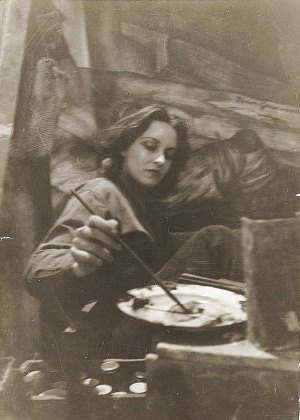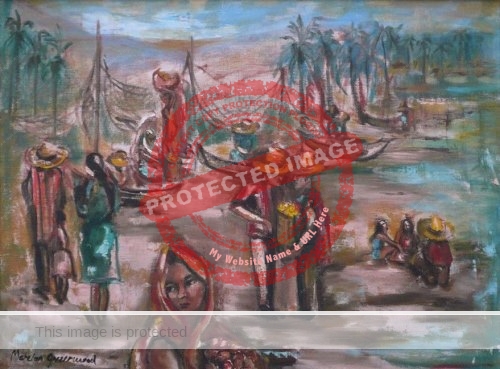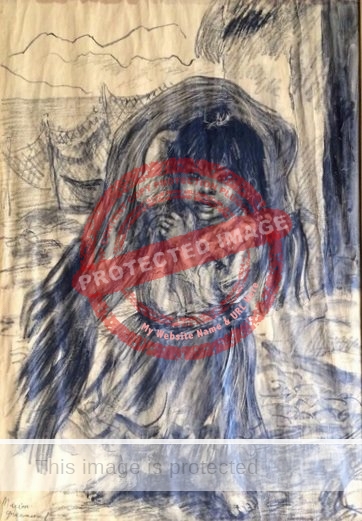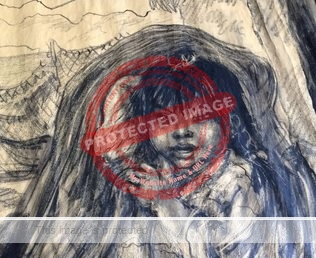American artist Marion Greenwood (1909-1970) was definitely in Chapala at least once, as evidenced by a water-damaged drawing entitled “Chapala girl”, dated 1969 and offered for sale on eBay in 2017.
Greenwood traveled south of the border for the first time in December 1932 and spent several years in Mexico, where she is best known as a muralist.
Born in Brooklyn on 6 April 1909, Greenwood displayed artistic talent from childhood. She left high school at age 15 to attend the Art Students League in New York where she studied under John French Sloan and George Bridgman. She also studied lithography with Emil Ganso and mosaic with Alexander Archipenko.
While still only a teenager, she made several visits to Yaddo, an artists’ retreat in Saratoga Springs, New York, to meet fellow artists and paint portraits of visiting intellectuals. A portrait of a wealthy financier gave her the funds to travel to Europe where she studied briefly at the Academie Colarossi in Paris.
In 1930 she was back in New York and drawing theater-related sketches for The New York Times.
The following year she made the first of several trips to the Southwest to paint Navajo Indians. From there she drove to Mexico City where she met artists Leopoldo Mendez, Alfredo Zalce and Pablo O’Higgins, who had worked with Diego Rivera and introduced her to fresco painting.

Marion Greenwood. Archives of American Art.
Greenwood spent some time experimenting in Taxco in 1932, where she completed a fresco of native life on the stairwell at the Hotel Taxqueño. After returning to Mexico City, she was introduced to Gustavo Corona Figueroa, the rector of the Universidad Michoacana de San Nicolás de Hidalgo (in Morelia, Michoacán), the oldest institution of higher education in the Americas. Milan commissioned Greenwood to paint some frescos in the university and Greenwood decided to portray the everyday lives of the local Tarascan people.
Mexican students at the university initially ignored Greenwood’s work but began to take a serious interest after presidential candidate Lázaro Cárdenas visited, met Greenwood and praised her work-in-progress. Greenwood’s final work, known as Paisaje y economía de Michoacán (Landscape and economy of Michoacán), painted in 1933-1934, still adorns the second story of the university’s main patio.
Marion’s older sister, Grace Greenwood, also an artist, had joined her in Mexico City and both women had become members of the Liga de Escritores y Artistas Revolucionarios (League of Revolutionary Writers and Artists) to which Diego Rivera and many other famous artists belonged. In 1934, a group of Liga artists was commissioned to decorate the newly-constructed Mercado Abelardo L. Rodríguez in downtown Mexico City. The artists involved were Pablo O’Higgins, Ramón Alva Guadarrama, Antonio Pujol, Pedro Rendón, Miguel Tzab Trejo and Angel Bracho. O’Higgins used his influence to have Grace and Marion Greenwood added to the group. The murals were completed by early 1936. In April 1936, shortly after the Greenwood sisters had returned to the U.S., the Washington Post reported that Diego Rivera had named them “the greatest living women mural painters.” [quoted in Oles]

Marion Greenwood. Mexican Fishing Village.
In the late 1930s, Greenwood taught fresco painting at Columbia University and completed murals for the social hall of the Westfield Acres Housing Project in Camden, New Jersey, and for the post office in Crossville, Tennessee. In 1940, she received a WPA commission to paint frescoes for the low-income Red Hook housing project in Brooklyn.
After 1940, Greenwood focused more on easel painting and printmaking than on frescos and murals. During the second world war she was one of only two women appointed as an artist war-correspondent. Her paintings, drawings and etchings of wounded and recovering soldiers are housed in the official archives of the U.S. War Department.
From 1944-46 Greenwood lived and worked in China. She continued to travel widely after her return to the U.S. Towards the end of the 1940s, Greenwood moved away from New York City and settled in Woodstock in upstate New York.
The context and details of her visit to Chapala in 1969 are unknown. Despite some water damage, her drawing entitled “Chapala Girl” dating from that visit is wonderfully evocative.

Marion Greenwood. 1969. Chapala girl. (damaged drawing – best available illustration)
If anyone can fill in the details of Greenwood’s visit to Chapala, please get in touch!

Marion Greenwood. 1969. Chapala girl (detail). (damaged drawing – best available illustration)
Greenwood’s solo shows include Associated American Artists (Hong Kong) (1946, 1947, 1948); American Contemporary Artists Gallery; Corcoran Gallery in Washington D.C.; Whitney Museum, New York; Museum of Modern Art (MoMA, New York); and the New York World’s Fair.
Greenwood won numerous awards for her art including the Lithography Prize from John Herron Art Institute, Lippincott Figure Prize at Pennsylvania Academy of Fine Arts, both the Altmann Figure Prize and the Lillian Cotton Award at the National Academy of Design, and The Grumbacher Prize.
In addition to her many murals on public buildings, examples of Greenwood’s works can be found in the permanent collections of the Museum of Modern Art, the Library of Congress, New York Public Library, the Bibliothèque Nationale in France, Pennsylvania Academy of Fine Arts, the Tel Aviv Museum, Yale Museum, Boston University, the Butler Art Institute, Newark Museum, Mint Museum, Montclair Art Museum, Norfolk Museum, National Academy of Design, New Britain Art Institute, John Herron Art Institute and Smith College.
Marion Greenwood died on 20 August 1970 at the age of 61.
Sources:
- Manuel Aguilar-Moreno and Erika Cabrera. 2011. Diego Rivera: A Biography. Santa Barbara, California: Greenwood biographies.
- Angelica Martinez-Sulvaran. 2017. Marion Greenwood: A Modern Woman in Modern Mexico. Docomomo US. 9 January 2017.
- James Oles. 2004. “The Mexican Murals of Marion and Grace Greenwood.” chapter 7 in Laura Rachel Felleman Fattal and Carol Salus (eds) Out of Context: American Artists Abroad. Greenwood Publishing Group.
- Charlotte Rubinstein. 1982. American Women Artists. Boston, MA: G.K. Hall & Co. pp. 217–220.
- Washington Post. 1936. “Marion Greenwood Applauded for Steady Rise to Mural Fame,” Washington Post, 12 April 1936.
Other artists and authors linked to both Lake Chapala and Woodstock, New York, include:
- Leonora Baccante (ca 1905-?)
- Sam Eskin (1898-1974)
- Lee F. Hersch (1896-1953)
- Walt Peters (1894-1985)
- Alfredo Santos (born 1927)
- Haig Shekerjian (1922-2002)
- Clara Schafer Thorward (1887-1969)
Sombrero Books welcomes comments, corrections or additional material related to any of the writers and artists featured in our series of mini-bios. Please email us or use the comments feature at the bottom of individual posts.
Tony Burton’s books include “Lake Chapala: A Postcard History” (2022), “Foreign Footprints in Ajijic” (2022), “If Walls Could Talk: Chapala’s historic buildings and their former occupants” (2020), (available in translation as “Si Las Paredes Hablaran”), “Mexican Kaleidoscope” (2016), and “Lake Chapala Through the Ages” (2008).